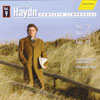Haydn Symphonies Nos 70, 73 & 75
Haydn well out of the comfort zone but with perversity alongside brilliance
View record and artist detailsRecord and Artist Details
Composer or Director: Joseph Haydn
Genre:
Orchestral
Label: Classic
Magazine Review Date: 6/2008
Media Format: CD or Download
Media Runtime: 62
Mastering:
Stereo
DDD
Catalogue Number: CD98 517

Tracks:
| Composition | Artist Credit |
|---|---|
| Symphony No. 70 |
Joseph Haydn, Composer
Heidelberg Symphony Orchestra Joseph Haydn, Composer Thomas Fey, Conductor |
| Symphony No. 73, '(La) chasse' |
Joseph Haydn, Composer
Heidelberg Symphony Orchestra Joseph Haydn, Composer Thomas Fey, Conductor |
| Symphony No. 75 |
Joseph Haydn, Composer
Heidelberg Symphony Orchestra Joseph Haydn, Composer Thomas Fey, Conductor |
Author: Richard Wigmore
In maximum contrast, Fey conducts the slow movements con amore, with a chamber-musical finesse. The alternating minor-major variations in No 70 (ludicrously described in the booklet as “a rondo in sonata form with variations in double counterpoint”) are beautifully paced and coloured, the filigree violin-writing delicately shaped, the repeats enhanced by fresh nuances and dynamic shadings. In the lovely Poco adagio variations of No 75 the repeats are more creatively embellished, with a mini-violin cadenza inserted at one point. This might get slightly irritating after the third or fourth hearing, though not, I suspect, as irritating as Fey's extreme tempo manipulations in the finales. I'm all for maximising the shock effect of Haydn's pauses. But why does he need to play slow and loose with the final page of No 75 when Haydn has already written the drastic lull in activity into the music? Fey is equally perverse in the astonishing D minor finale of No 70, teasing out the framing sections to absurd lengths. The upshot is that Haydn's edgy, faintly inscrutable humour becomes self-consciously laboured. All the more frustrating, then, that the movement's fugal centrepiece has a splenetic intensity I have never heard equalled. That rather sums it up.
Discover the world's largest classical music catalogue with Presto Music.

Gramophone Digital Club
- Digital Edition
- Digital Archive
- Reviews Database
- Full website access
From £8.75 / month
Subscribe
Gramophone Full Club
- Print Edition
- Digital Edition
- Digital Archive
- Reviews Database
- Full website access
From £11.00 / month
Subscribe
If you are a library, university or other organisation that would be interested in an institutional subscription to Gramophone please click here for further information.




